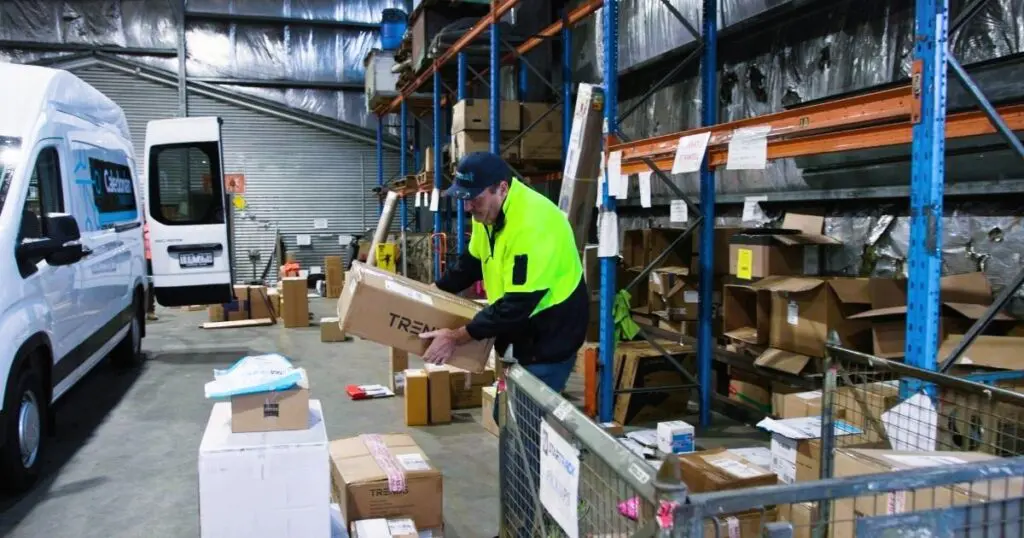Table of Contents
Hub and Spoke, Point 2 Point, Full Truckload… There’s always a lot to consider in the logistics game.
Let’s take you briefly through exactly what the hub and spoke model is, and how you can make the most of it by increasing efficiency, automating tasks, and saving time, fuel and costs.
Hub and Spoke: How it Impacts Transport and Distribution
Transport and distribution ensure that goods move efficiently from origin to destination.
One of the most effective ways to manage this process is through the hub and spoke model—a network topology that connects multiple locations (spokes) to a central hub.
This spoke model allows for efficient communication and streamlined distribution of freight, helping businesses reduce costs and improve their operations.
By leveraging the hub and spoke system, organizations can optimize their networks, enhance resource allocation, and achieve significant cost savings.
Understanding how this model works is essential for any business looking to stay competitive, as it enables better connectivity, faster deliveries, and of course, customer satisfaction.
Network Topology: How Distribution Networks Are Structured
In logistics, how you structure your network can have a major impact on the efficiency and success of your operations.
The hub and spoke model is a popular network topology, featuring a central hub that connects to multiple spoke locations. This setup allows for efficient communication and easy management of goods as they move through the network.
Compared to other network topologies—like mesh topology, where every location is interconnected, or star topology, which also uses a central point but with different routing logic—the hub and spoke model stands out for its simplicity and scalability. By choosing the right network topology, businesses can ensure their distribution operations are both efficient and adaptable to changing demands.
What is the hub and spoke model?
The hub and spoke model is a distribution network that unsurprisingly resembles a bicycle wheel. The hub sits in the middle and allows each of the spokes to move in one direction of delivery and meet at a central location.
This structure is also known as a hub and spoke network, which connects multiple locations or resources through a central hub.

The model is commonly used across Australia and the rest of the world. For example in big grocery chains: food and consumer goods from various locations are loaded into a single truck and then transported to one store together for last mile delivery.
It’s also the model that airports use to move people around the world. Airports function as central hubs in a global spoke network, facilitating the efficient movement of people and goods. In this context, spoke networks connect to central hubs to streamline operations and enable efficient communication and resource sharing.
Whether talking about goods or people, you can see the hub and spoke model is extremely common and useful, too. In large or geographically dispersed systems, multiple hubs may be used to improve coordination and efficiency.
Here are some real-world examples of hub and spoke networks in logistics, air travel, and telecommunications.
It’s essential to our international and national economies, especially for a country as geographically spread out as Australia.
What transport carriers use hub and spoke distribution?
It should make sense that Less Than Truckload (LTL) shippers are the ones to utilise the hub and spoke model.
The fundamental purpose of an LTL shipment is to carry numerous smaller shipments in a single truck to a destination.
By using a hub and spoke system, carriers can streamline processes and optimize routes within their logistics systems, ensuring efficient coordination and resource allocation.
It’s not cost-effective or efficient to send a single pallet from Sydney to Melbourne, so an LTL carrier will set up a series of distribution centres where the trucks can be fully loaded with various shipments going to the same destination.
This not only saves on transportation costs, it also speeds up your chain and increases delivery efficiency.
Point to Point Model: An Alternative Approach
The point to point model offers a different approach to distribution, where each location is directly connected to every other location in the network. This model can provide the fastest route between two points, making it ideal for certain high-priority or time-sensitive deliveries.
However, as the number of locations increases, the network becomes more complex and expensive to manage.
In contrast, the hub and spoke model centralizes connections through a hub, making it a more cost-effective and scalable solution for most logistics operations. By understanding the strengths and limitations of both the point to point model and the hub and spoke model, businesses can make informed decisions about their distribution strategies, ensuring they choose the network topology that best fits their operational needs and budget.

In an ideal world, every shipper will manage their schedules with single truckloads heading to single destinations. And then return with another full truckload.
Of course, the reality in transport and distribution just isn’t that simple.
The hub and spoke model simplifies the real world process of shipping smaller, messier freight.
While most LTL shippers can’t use Full Truckload (FTL) shippers, the model gives everyone the flexibility needed to move goods.
The central hub is set up to receive, route, load and launch multiple shipments to single destinations. Utilising a software that works for the hub and spoke model will automate most of your required tasks and make something that’s quite complex become quick and easy. The complexity of logistics operations is managed by the central hub, where shipments are processed efficiently. A hub network can also centralize shared services, improving coordination and resource allocation.
Benefits for Customers and Carriers
Increasing efficiency across the board means that retailers, agents, carriers, drivers and consumers all feel the benefits.
The hub and spoke model offers many benefits, such as improved access to resources, enhanced security, and lower costs for businesses of all sizes.
Your transportation cost per delivery will come down. A hub can receive large volumes of LTL shipments each day, storing the freight until an appropriate route, truck and destination are ready. This doesn’t take long because hubs are a hive of activity and there’s always new shipments arriving. The trucks don’t take long to fill up.
For the LTL company, it saves fuel, wages and time. They can then pass those savings on to customers by optimizing the use of resources and lowering operational costs.
Centralized management in the hub and spoke model also helps mitigate security threats by streamlining network security and monitoring, while supporting better decision making for logistics companies.
When the hub and spoke model becomes automated, customer service teams also benefit. Automated communication is quick and easy (and cheaper), and when something goes missing, track and trace is easier too with increased visibility.
As technology evolves, so will shipping
Modern hub and spoke networks can connect cloud resources with on premises infrastructure, forming a hybrid on premises network that integrates both environments. Centralized management in this model allows for monitoring different ports and ensuring secure communications across the network. Secure connections between the hub and spokes facilitate safe data transfer and help maintain the integrity of the network. For example, an instance of redundancy can be implemented by establishing hybrid connections that activate backup links if the primary connection fails. The following diagram illustrates how these connections are structured within a hub and spoke network.
However as technology changes, the hub and spoke model will evolve too, offering shippers and carriers alike more flexibility, faster deliveries, and better customer service. If the hub and spoke model does not meet your needs, explore other network models to find the best fit for your organization. Informed decision making, supported by network analysis tools, is essential when choosing between network architectures. This means that choosing a cloud-based software that can update regularly and keep up with these changes is essential.
Back to you
Have you got any questions remaining?
Our friendly team of Aussie transport veterans are well versed in the hub and spoke distribution. We can talk you through how our software will work for your business (because we know no two businesses are quite alike).
Get in touch when you’re ready, we’re always here to help.



